On the brink of Modernity, artists all over the globe buzzed
with anticipation of a new, avant-garde art movement that allowed painters,
sculptors, and architects alike to break free from traditional means of
artistic patronage and dive head-first into a movement that inspired change,
growth, and, for the first time, an uninhibited freedom to create. At the forefront
of this crusade was a new mechanism of art that had not yet been explored prior
to the 19th century: photography. Although members of the Avant-garde
movement sought to break away from the strict rules of the Salons, a body of
wealthy patrons who took it upon themselves to define what qualified as “art”, and
singlehandedly destroying the integrity of any work that strayed from their
ideals, artists remained wary of this budding medium which was unlike any
method ever used before. Those opposed to photography as a fine art believed
that it was a machine that captured the image, not the artist himself. Because
of this, many early photographers sought to make their prints resemble fine paintings.
A prime example of this technique
is Oscar Rejlander’s photograph “The Two Ways of Life” as compared to the
famous artist Raphael’s “The School of Athens”. Similar in composition and subject
matter, these two works are unmistakably linked. Raphael’s most notable masterpiece, “The
School of Athens” is a large fresco painted on the interior of the Apostolic
Palace in the Vatican. In it are portraits of the great thinkers Aristotle,
Plato, and a self-portrait of Raphael himself. The setting in which the
painting takes place is a basilica-shaped church, the Greek cross layout
symbolizing the intersection of pagan philosophy and Christian theology, two
major ideologies flourishing at the time. Framing the painting are allusions to
Greek mythology. High-relief sculptures of the god Apollo and goddess Athena buttress
the themes of renaissance thinking such as music, wisdom, and rebirth of the culture
of classical antiquity.
Likewise, Rejlander’s photograph,
composed of over thirty different images combined into one complete arrangement,
has many similar references. “Rejlander emulated not only the artistic methods
and ambitions of academic masters, but also their pretensions to high moral
purpose.” (Arnason, 16) “The Two Ways of Life” tells the story of a pair of men
presented with two different paths of life; the path of morality, vice, and
virtue, and a life of “sin that so easily entangles”. Amidst the young apprentices
stands a wise patriarch, guiding and imparting knowledge as Plato instructed
Aristotle. On one half of the composition are erotic scenes of sexual
indulgence, gambling, and lust, while the other half comprises ethical scenes
of philanthropy, humanitarianism, and academia. Not only are the figures presented
in a lackadaisical manner, lounging on the steps of an Italian cathedral as in “The
School of Athens”, but their mannerisms and placement are also parallel. Architectural
features such as the arched entryway, marble staircase and doric columns of
Rejlander’s building mirror elements used in Raphael’s famous mural as well.
As time went on, this sudden shift
from traditional means of artistic creation to modern techniques became more
widely accepted. Photography as a method of fine art became more universally
regarded as artists began to “purge their work of the artificial, academic
devices…and instead report the world and its life candidly.” (Arnason 16) With
the emergence of artists like Daguerre and William Henry Fox Talbot, who
revolutionized photographic procedures with their creation of the Daguerrotype
and Callotype, photography’s place in the art world not only established, but thrived,
setting the stage for countless iconic works to come.







_(1).jpg)









